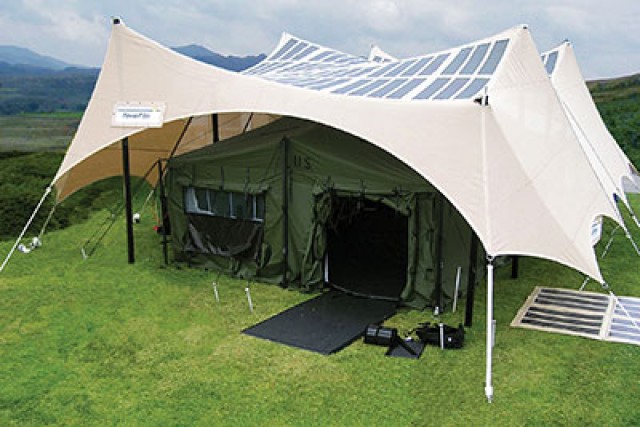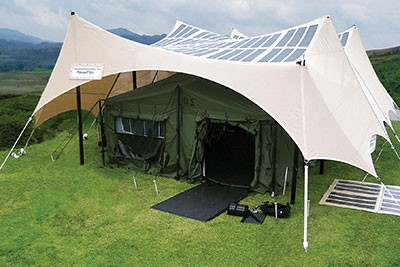ARLINGTON, Va. (Army News Service, Dec. 8, 2010) -- The U.S. Army is evaluating a host of flexible, portable, lightweight solar-powered shades and tent-like technologies.
The products are designed to allow expeditionary units to deploy with transferrable, exportable electrical power that can charge batteries, computers and other essential gear without needing fuel or a generator, service officials said.
Using a fast-evolving technology known as Flexible Photovoltaics (PV), the solar-powered tent structures convert light energy into electricity, thus removing the need to haul generators and large amounts fuel.
Aca,!A"They are ideal for charging up batteries, making sure your (communications), night vision goggles and computers are powered up. You donAca,!a,,ct want a generator on top of a mountain, and you donAca,!a,,ct want to have to bring fuel to a generator or haul batteries,Aca,!A? said Katherine Hammack, assistant secretary of the Army for installations, energy and environment.
Technological advances in the area of photovoltaics have made it possible to build lightweight, portable materials which are flexible and can easily travel with dismounted units.
In fact, the Army has already deployed some of these technologies to forward locations around the world for additional evaluation, sending some to places such as Afghanistan, said Steven Tucker, a senior engineer in the Shelters Technology, Engineering and Fabrication Directorate at the Natick Soldier Research Design and Engineering Center.
In addition, Hammack said the Army is hoping to deploy more of the solar-powered tents in the near future.
Aca,!A"The technology has reached the point where the testing has shown they [solar-powered tents] are proven. Our teams have worked on the inverters and the durability of the systems. The durability of the tent covers has evolved to a point where we would like to see more of them deployed,Aca,!A? Hammack said.
Some of the Flexible PV products being evaluated are called: Power Shade, TEMPER Fly and QUADrant Aca,!" military shelter items of various sizes and configurations which use flexible solar panels to harness light energy and convert it into transferable electricity.
Aca,!A"The technology we are using is called amorphous silicon. ItAca,!a,,cs been around since the early 80s. It takes the energy from the sun Aca,!" photons. They [photons] go into the PV materials and they essentially knock loose electrons. Those electrons are then gathered and utilized for power, converting solar power to electrical power,Aca,!A? Tucker explained.
The TEMPER Fly is a roughly 16-by-20-foot tent structure able to generate 800 watts of electricity. A QUADrant is a smaller variant of the TEMPER Fly, able to generate 200 watts of power, and the Power Shades range in size and are capable of generating up to 3 kilowatts of exportable electrical power, Tucker said. The PV integrated military shelter items use a lamination process to combine the PV materials into the textile substrate, Tucker explained.
Aca,!A"Alternative energy sources are really going to shine in mission scenarios where you donAca,!a,,ct want to use a generator because you donAca,!a,,ct want the noise or heat signature that goes along with it, or where re-supplying that generator with fuel doesnAca,!a,,ct make sense,Aca,!A? said Tucker.
Related Links:
Army emphasis on energy security evidenced by new senior-level office
Army striving for 'net-zero' energy use
U.S. Army Natick Soldier Systems Center
Army.mil: Science and Technology News
STAND-TO!: Army Renewable Energy Initiative
Office of the Assistant Secretary of the Army, Installations, Energy and Environment


Social Sharing